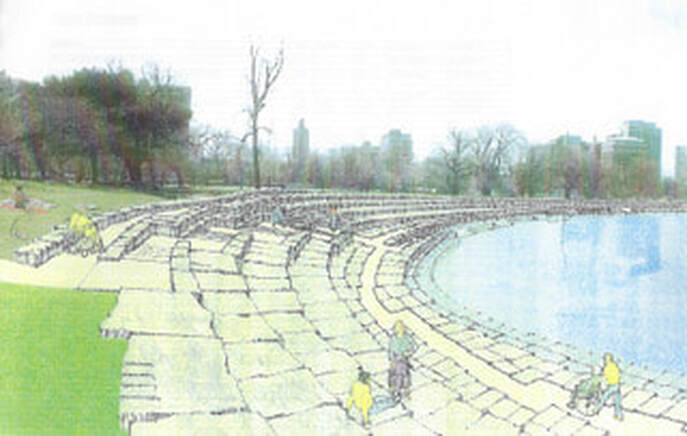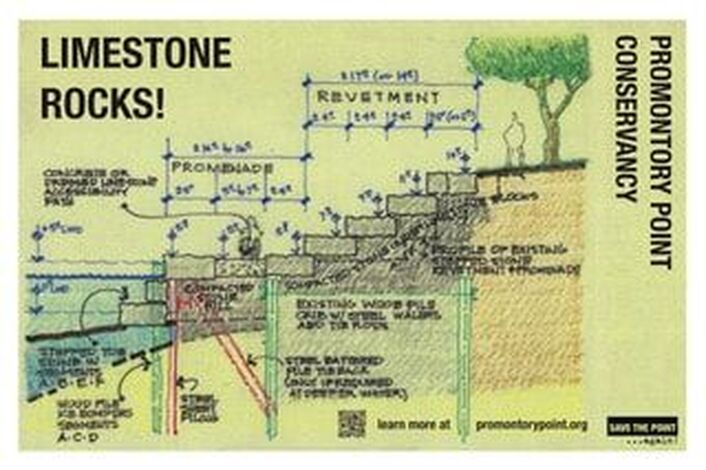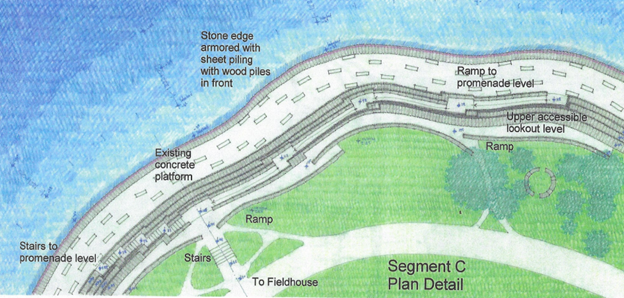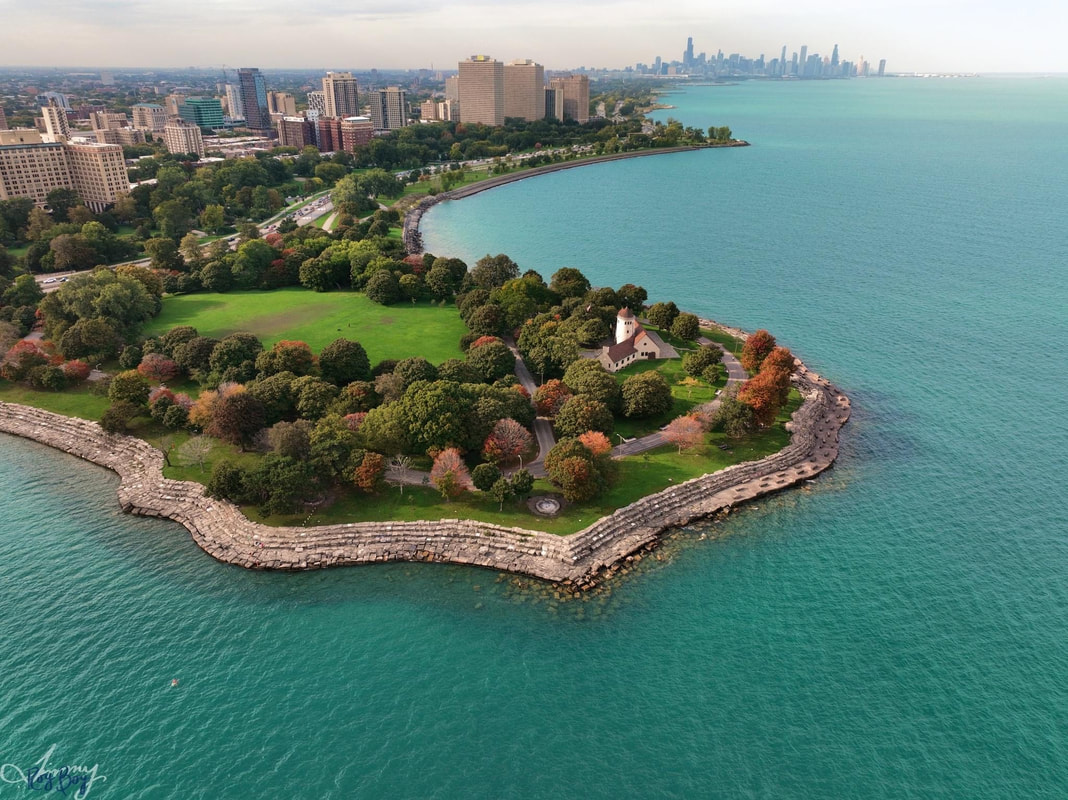Promontory Point Conservancy wins three prestigious grants!
The Richard H. Driehaus Foundation, the National Trust for Historic Preservation and Landmarks Illinois have awarded Promontory Point Conservancy generous grants to complete our coastal engineering design study and to hire an historic treatments consultant to write preservation studies. We are highly delighted and greatly honored by these awards! Read more.
Promontory Point Conservancy released the McLaren Engineering Group's Condition Study of Promontory Point on April 4. This Condition Study irrefutably demonstrates that the historic limestone revetment functions for storm damage and shoreline protection satisfactorily right now, can be retained and repaired, and, if repaired and maintained, has another 86-or-more years of service. It refutes the City's findings that the revetment has failed and must be replaced with concrete. The Conservancy co-hosted a press conference with Alderman Desmon Yancy to release this important Study.
Read the Promontory Point Condition Study, McLaren Engineering Group, April 4, 2024. Catch this Fact Sheet, summarizing key findings of the Condition Study. Peruse the Condition Study's appendices A, B, C and D. On June 5, the Conservancy also hosted a Q&A session with McLaren's engineers about the condition study for preservation agencies, preservation organizations, the Army Corps, City and Chicago Park District. Here is the recording (55 min.)
Read our press statement about McLaren's determinations and watch the highlights of the press conference itself: four-minute and nine minute excerpts or the full-monty Read our press statement in response to CDOT's press statement about our condition study. Read press coverage about our press conference and McLaren's Condition Study.
Stay tuned for McLaren's Alternatives Design Plan in the fall with low-, medium- and high-cost options for repairing and rehabilitating the Point's revetment without destroying it. See below for architectural drawings on how ADA accessibility might be work at the Point.
Read the Promontory Point Condition Study, McLaren Engineering Group, April 4, 2024. Catch this Fact Sheet, summarizing key findings of the Condition Study. Peruse the Condition Study's appendices A, B, C and D. On June 5, the Conservancy also hosted a Q&A session with McLaren's engineers about the condition study for preservation agencies, preservation organizations, the Army Corps, City and Chicago Park District. Here is the recording (55 min.)
Read our press statement about McLaren's determinations and watch the highlights of the press conference itself: four-minute and nine minute excerpts or the full-monty Read our press statement in response to CDOT's press statement about our condition study. Read press coverage about our press conference and McLaren's Condition Study.
Stay tuned for McLaren's Alternatives Design Plan in the fall with low-, medium- and high-cost options for repairing and rehabilitating the Point's revetment without destroying it. See below for architectural drawings on how ADA accessibility might be work at the Point.
The conflict between true preservation and the Chicago Corps, CDOT and CPD's plan for demolition and replacement with concrete is succinctly presented in this video here (4:14) by Hans Friedl.
Photo credits, left to right: Kurt Elling, Bill Stamets, Bill Stamets
Promontory Point Conservancy Holds the City To Its Preservation Commitment at Promontory Point
In early February, the Conservancy learned that the City of Chicago (CDOT) had quietly issued its RFP for a $5m design planning study of Promontory Point to prequalified firms and that it would be selecting its contractor soon. Our discovery forced CDOT to release a press statement on February 22, saying that it had, indeed, clandestinely issued its RFP, selected its contractor of record SmithGroup and is negotiating a contract. On the same day, at the insistence of 5th Ward Alderman Desmon Yancy, CDOT and the Chicago Park District (CPD) committed to "a preservation-based approach" at a local community meeting.
We continue to be disturbed by the lack of transparency for a highly scrutinized project, about the sky-high price tag for this design study when the City faces a budget shortfall, and by CDOT rushing ahead and outpacing its federal partner. Read the Conservancy's February 26 press statement. Read the Advisory Council on Historic Preservation's letter, dated March 7, 2024, to the Chicago Army Corps expressing its concerns about how the federally funded project at Promontory Point is being managed.
In early February, the Conservancy learned that the City of Chicago (CDOT) had quietly issued its RFP for a $5m design planning study of Promontory Point to prequalified firms and that it would be selecting its contractor soon. Our discovery forced CDOT to release a press statement on February 22, saying that it had, indeed, clandestinely issued its RFP, selected its contractor of record SmithGroup and is negotiating a contract. On the same day, at the insistence of 5th Ward Alderman Desmon Yancy, CDOT and the Chicago Park District (CPD) committed to "a preservation-based approach" at a local community meeting.
We continue to be disturbed by the lack of transparency for a highly scrutinized project, about the sky-high price tag for this design study when the City faces a budget shortfall, and by CDOT rushing ahead and outpacing its federal partner. Read the Conservancy's February 26 press statement. Read the Advisory Council on Historic Preservation's letter, dated March 7, 2024, to the Chicago Army Corps expressing its concerns about how the federally funded project at Promontory Point is being managed.
Destination Point: The Legitimate Community Preservation Plan
|
The community is the Point: preserving the historic limestone revetment preserves the community that has gathered at the Point for nearly a hundred years.

There are many ways that rehabilitation at the Point might work to maximize the historic limestone revetment, minimize concrete and still provide ADA access to the promenade and water for all. Here graceful ramps lead down to and into the water. This drawing dates from 2003 when the Conservancy worked with universal access organizations and ADA architects on creative ADA modifications.

This drawing illustrates the step-stone, limestone revetment being repaired-in-place or with in-kind breakwater limestone blocks. The wooden crib pilings are replaced with new wooden or steel cribbing so that the revetment can easily drain. The missing subgrade fill under the promenade can be cheaply replaced with foaming concrete or new compacted fill and held in place with new microfiber coverings so that the promenade stones can be repositioned and stay put in the future.

Dating from 2003, this drawing shows another option for ADA compliance. Preservation rehabilitation allows for an easy adaptation for ADA access to the promenade and water for all on the east end of Promontory Point, where the 1965 concrete platform with wave deflectors -- called the "coffins" by the public -- forms the promenade. Accessibility ramps connect the coffin promenade to the nearby fieldhouse washrooms and the walking pathways.
Vanishing Point: The City's fully funded $5m design study and the Chicago Army Corps's planned 2026 construction at Promontory Point
Watch CDOT's "preferred solution" for the Point's limestone revetment (18 seconds. 2022). On its official project webpage, CDOT states: "the preferred design of the revetment is . . . concrete steps and promenade to replace the existing stones. This design maintains safe access to the shoreline while preserving its historic and aesthetic value".
The Chicago Division of the U.S. Army Corps of Engineers publicly states on its official project webpage that the "original shoreline structures . . . no longer function" and it will "replace existing infrastructure and construct new structures". The Chicago Corps describes the multiple-funded undertaking in this press release.
This is not legal, genuine preservation as the City, CPD and the Corps now say they are committed to carrying out at Promontory Point. CDOT and CPD’s public statements commit only to “repurposing", “saving and reusing as much of the existing limestone as possible”. "Replacement", “repurposing" and “reusing" are NOT Secretary of the Interior preservation standards.
 Photo credit: David Schalliol
Photo credit: David Schalliol
2024 Promontory Point volunteer clean-up schedule
Sundays, 10:30am - noon: July 21, August 18, September 22, October 20, November 10. We meet at the National Register plaque, east side of the tunnel/underpass. We provide gloves, trash bags, tools and FREE Save the Point Again! t-shirts. See you at the Point!
Sundays, 10:30am - noon: July 21, August 18, September 22, October 20, November 10. We meet at the National Register plaque, east side of the tunnel/underpass. We provide gloves, trash bags, tools and FREE Save the Point Again! t-shirts. See you at the Point!
Promontory Point: now a Chicago Landmark! The Chicago City Council voted Promontory Point a Chicago Landmark on April 19, 2023! Read the 537 letters of support from Point lovers here. Read the Chicago Landmark Designation Report here. Promontory Point was listed on the National Register of Historic Places on January 19, 2018.
Find out how the legitimate community preservation plan is cheaper than the City's plan by many millions of dollars
Promontory Point was twice listed on Preservation Chicago's Most Endangered Seven in 2006 and again in 2022
Historian Bill Swislow maps the 500 carvings on the limestone revetment at Promontory Point that you can walk yourself. The 6-page map is downloadable and printable as well as interactive. Read Bill's statement about these carvings and their unique history
Find out how the legitimate community preservation plan is cheaper than the City's plan by many millions of dollars
Promontory Point was twice listed on Preservation Chicago's Most Endangered Seven in 2006 and again in 2022
Historian Bill Swislow maps the 500 carvings on the limestone revetment at Promontory Point that you can walk yourself. The 6-page map is downloadable and printable as well as interactive. Read Bill's statement about these carvings and their unique history
Photo credit: Tim Murphy
Questions about an event, swimming buoys or donations for a bench?
The Conservancy does NOT issue park permits for BBQs, weddings, or other events, and it does NOT take donations for memorial benches or trees at the Point. The Chicago Park District and the Chicago Parks Foundation do: Here is the information on the Park District's website about grilling in parks: Here is information on the Park District's website about whether your event will require a permit: For permit inquiries and general questions about events at the Point, contact Park Supervisor Monique Scott at +1.312.742.5369
For inquiries about a dedicated memorial bench at the Point, contact the Chicago Parks Foundation: For missing swim buoys, park damage, parked cars, locked bathrooms during park hours, safety concerns, maintenance issues or other problems in the park, contact the Chicago Park District directly
For inquiries about a dedicated memorial bench at the Point, contact the Chicago Parks Foundation: For missing swim buoys, park damage, parked cars, locked bathrooms during park hours, safety concerns, maintenance issues or other problems in the park, contact the Chicago Park District directly






